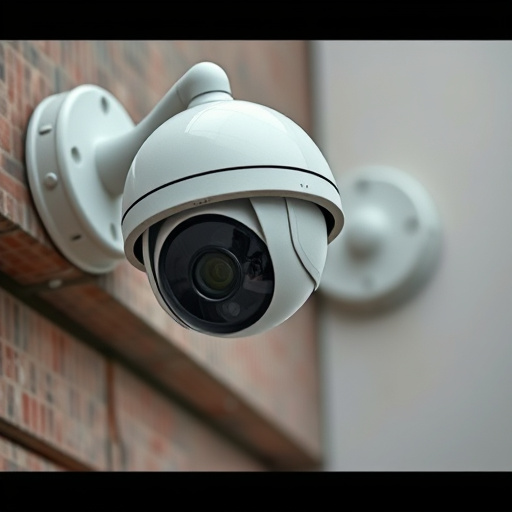Strategically placed fake CCTV cameras significantly reduce crime rates by up to 60% due to their realistic design and visible presence, acting as powerful deterrents in residential, commercial, and public spaces. Mounting them at optimal heights (2-3 meters) and eye level or slightly elevated positions enhances their effectiveness, while placing them near entry points and high-risk areas further boosts security. Research shows that the psychological impact of these decoys discourages criminal activity, making them a highly effective deterrent solution without needing extensive physical monitoring.
In today’s world, enhancing security is a top priority for many. One often-overlooked tool in this regard is the fake security camera. This guide explores the deterrent effectiveness of Fake CCTV Cameras and how their strategic mounting height can significantly impact visibility and intimidation. We’ll delve into best practices for optimal placement, real-world implementation success stories, and ways to foster heightened security awareness through strategic fake camera installation. Understanding these aspects can help you maximize the benefits of this cost-effective security solution.
- Understanding Fake Security Cameras and Their Deterrent Effectiveness
- The Impact of Mounting Height on Camera Visibility and Intimidation
- Best Practices for Optimizing Fake CCTV Camera Placement
- Real-World Examples: Successful Implementation Strategies
- Enhancing Security Awareness through Strategic Fake Camera Installation
Understanding Fake Security Cameras and Their Deterrent Effectiveness
Fake security cameras, also known as decoy or dummy CCTV cameras, are an effective deterrent for potential thieves and intruders. Their presence can significantly impact crime rates in residential, commercial, and public spaces. These cameras simulate real surveillance equipment, often mimicking the look and design of traditional CCTV cameras with high-quality replicas. The primary purpose is to deter criminal activities by conveying a strong message that any attempt at illegal entry or theft will be closely monitored.
The deterrent effectiveness of fake security cameras lies in their strategic placement and realistic appearance. When installed in visible areas, they can prevent crimes from occurring as offenders may perceive them as active surveillance systems. This perception creates an environment where individuals are less likely to engage in unlawful activities, thereby enhancing the overall security of a location. Research has shown that having visible fake CCTV cameras can reduce crime rates by up to 60% in certain areas.
The Impact of Mounting Height on Camera Visibility and Intimidation
The mounting height of security cameras plays a significant role in their effectiveness as deterrent devices. Lower mounted cameras might offer better coverage but can be less intimidating, potentially reducing their deterrent effect on potential criminals. On the other hand, cameras positioned at optimal heights—generally between 2 to 3 meters (6.5 to 10 feet) above the ground—can provide a clear line of sight while still appearing noticeable and menacing. This height offers an ideal balance between visibility and intimidation, making it a popular choice for both residential and commercial security systems.
When considering the deterrent effect of fake CCTV cameras, the mounting height is key. While real or well-designed fake cameras at higher levels can significantly deter criminals due to their enhanced line of sight and perceived surveillance capabilities, lower mounts may not achieve the same level of impact. Thus, for optimal deterrent effectiveness, it’s crucial to follow best practices for camera placement, ensuring that security systems appear both visible and imposing from potential intruders’ perspectives.
Best Practices for Optimizing Fake CCTV Camera Placement
To maximize the deterrent effect of fake security cameras, optimal placement is key. Positioning them at eye level or slightly elevated offers a convincing visual presence, as real criminals are accustomed to avoiding direct line-of-sight surveillance. This reduces the likelihood of covert activities and increases the perceived risk for potential offenders.
Consider surroundings carefully; placing the cameras where they are visible from multiple angles can enhance their effectiveness. Strategically choosing locations near entry points, windows, or areas prone to theft or vandalism ensures a more comprehensive security network. Regularly reviewing and adjusting camera positions based on observed crime patterns can further boost their deterrent impact.
Real-World Examples: Successful Implementation Strategies
In real-world scenarios, strategically placed fake security cameras have proven to be an effective deterrent against crime. Businesses and homeowners alike have successfully used them to enhance their security measures. For instance, retail stores often mount these cameras at various angles and heights to monitor entry points and high-value areas, discouraging potential thieves. By simulating a comprehensive surveillance system, even the presence of fake CCTV can alter criminal behavior, making it less likely for individuals to target these locations.
The key to success lies in realistic designs that mimic genuine camera setups. When installed in visible locations, they send a clear signal that any unauthorized activity will be recorded and could lead to consequences. This psychological impact, coupled with the physical presence of cameras, creates an environment where criminals are more deterred from committing offenses, thereby boosting overall security and safety.
Enhancing Security Awareness through Strategic Fake Camera Installation
Fake security cameras, when strategically mounted at optimal heights, can significantly enhance security awareness and act as a powerful deterrent. By understanding the impact of mounting height on camera visibility and intimidation, and adhering to best practices for placement, individuals and businesses can maximize the effectiveness of these devices. Real-world examples demonstrate successful implementation strategies, highlighting the role of fake CCTV cameras in creating a safer environment.
